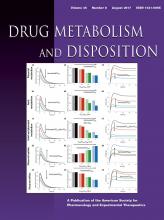Visual Overview
Abstract
Oxetanyl building blocks are increasingly used in drug discovery because of the improved drug-like properties they confer on drug candidates, yet little is currently known about their biotransformation. A series of oxetane-containing analogs was studied and we provide the first direct evidence of oxetane hydrolysis by human recombinant microsomal epoxide hydrolase (mEH). Incubations with human liver fractions and hepatocytes were performed with and without inhibitors of cytochrome P450 (P450), mEH and soluble epoxide hydrolase (sEH). Reaction dependence on NADPH was investigated in subcellular fractions. A full kinetic characterization of oxetane hydrolysis is presented, in both human liver microsomes and human recombinant mEH. In human liver fractions and hepatocytes, hydrolysis by mEH was the only oxetane ring-opening metabolic route, with no contribution from sEH or from cytochrome P450-catalyzed oxidation. Minimally altering the structural elements in the immediate vicinity of the oxetane can greatly modulate the efficiency of hydrolytic ring cleavage. In particular, higher pKa in the vicinity of the oxetane and an increased distance between the oxetane ring and the benzylic nitrogen improve reaction rate, which is further enhanced by the presence of methyl groups near or on the oxetane. This work defines oxetanes as the first nonepoxide class of substrates for human mEH, which was previously known to catalyze the hydrolytic ring opening of electrophilic and potentially toxic epoxide-containing drugs, drug metabolites, and exogenous organochemicals. These findings will be of value for the development of biologically active oxetanes and may be exploited for the biocatalytic generation of enantiomerically pure oxetanes and diols.
Footnotes
- Received April 24, 2017.
- Accepted June 5, 2017.
This work was presented in preliminary form at the 21st International Symposium on Microsomes and Drug Oxidations; 2016 Oct 2–6, Davis, CA.
↵
 This article has supplemental material available at dmd.aspetjournals.org.
This article has supplemental material available at dmd.aspetjournals.org.
- Copyright © 2017 by The American Society for Pharmacology and Experimental Therapeutics
DMD articles become freely available 12 months after publication, and remain freely available for 5 years.Non-open access articles that fall outside this five year window are available only to institutional subscribers and current ASPET members, or through the article purchase feature at the bottom of the page.
|








